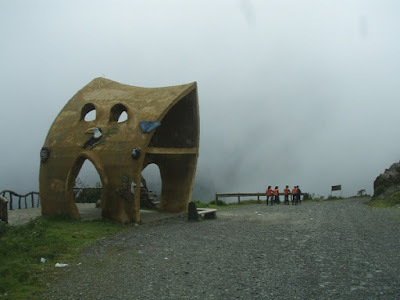I never thought touring an active mine would be on my bucket list, but today we did just that and I can check it off. The mine inside Cerro Rico has been in existence for nearly 500 hundred years, and is the main reason for the founding of Potosi, once one of the largest and wealthiest cities in the entire world due to its production of silver and other ores. During the height of Spanish rule, it is estimated that between 2 and 8 million people died in the mines, mostly African slaves and Amerindians forced to work until they could no longer. Today the mine is worked by both individual co-operatives and private companies seeking what little fortune is left in the hollowed mountain. Children as young as 12 work in the mine, and some spend a majority of their lives doing so.
Yesterday upon departing the office, we were told we would only be going on this tour with 2 others, but when we arrived this morning there were about 20 of us. We were broken into two groups, one with an English speaking guide, and the other Spanish. Our group turned out to be only 8 in total, including our awesome guide, which made for a more personal experience.
The first stop was the Miners Market. There the group purchased Bolivian made dynamite, black powder fuses, a bag of Ammonium Nitrate, juice, coca leaves, and cigarettes for the miners. Having never held explosives before, outside of fireworks, it was quite a thrill.
Next we changed into our gear for the day, consisting of rubber boots, a mud proof shirt and pant set to protect our clothes, and a headlamp with a belt holding the battery pack. We were then shown a processing center for the raw silver ore, where up to 200 tones of rock are sorted daily. Our imaginations were to work because the workers were all elsewhere due to the holiday.
We then made our way up the Cerro Rico. At the mine entrance, we encountered a group men loading bags of ore into a truck and our guide explained their monthly workload and how much the final product would bring the collective group. The section of the mine we would be visiting was a owned by the Bolivian Government, but rented out to Collectives of workers to exploit. There are also Private mines, which our guide seemed to be much more favorable of. They produced much more and in better conditions for the workers, but at a lower wage.
The entrance tunnel, we were told, is about 300 years old. It led to many other shafts, breaking off in what seemed to be random places, though they were carefully chosen due to the location of deposits. Our headlamps were our only light source as the mines have no electrical lights inside and no indication of any direction. Many of the walls were held up with primitive wooden beams and other contraptions. Our guide brought us through many tunnels, and showed us the differing types of ores, minerals, and chemical deposits that the volcanic mountain produced 80,000 years ago.
We only encountered a few miners along the way, which was fine for us, as more would have meant an excess of dust for us to inhale. Each miner we encountered received a collective gift from our group of either juice, coca leave, or dynamite and fuses. They did not seem put off by strangers in their workplace, though I suppose they meet with tourist frequently and only benefit from the interaction.
Of highlight to me was a moment we had while deep inside. Our guide had us all turn off our headlights and really experience the sensory deprivation of the pure darkness. Not a speck of light shown anywhere. He explained that some miners save money on lighting and work in these conditions. Unbelievable.
Towards the end, we had to get on our hands and knees to crawl through to the last site of the day, the Tio. The Tio is a shrine thought to bring good luck to the miners, who make offering to it. It was explained that the name Tio comes from "Dios" (God in Espanol), which could not be pronounced by the native Quechua speakers, as D is not in their phonetic alphabet. The statue was surrounded by coca leaves, cigarettes, and other offerings. At its base was a petrified llama, also a symbol of good luck as we have explained in a prior post. They even adorned him with a penis.
The tour was well worth the time and effort to come to Potosi. I would suggest this eye opening experience to anyone. I am grateful I had the opportunity to see how these men work in these very primitive conditions. The mine will run dry one day, and Potosi will cease to be even a remnant of what it is today, a remnant of a once powerful city.
Our New Years is going to be a quiet one this year. We have to hang in town until the 2nd, when we will be departing for Uyuni. Happy New Years everyone!
Gavin y June
P.S: There is an out of control fire in Torres Del Paine National Park right now, which may take weeks to contain. Unfortunately for us, we are supposed to be there in a little under a month. This was to be one of the highlights, and one of only 2 things we are doing in Chile, so we are hoping conditions change for the better.
more photos after the break:





















































